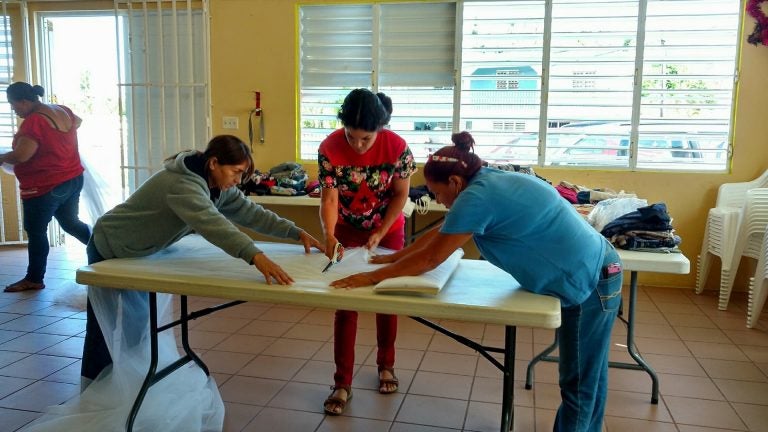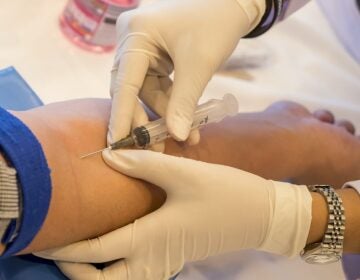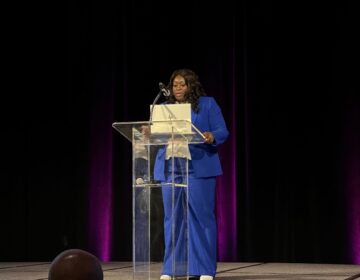In Puerto Rico, residents band together to defend against mosquitos
In Puerto Rico's mountain towns, grassroots community groups are finding purpose and protection by making homemade mosquito nets.
Listen 5:01
Rosita Canboh and community members in Barrio Las Vegas, Cayey, make mosquito nets for their neighborhood. Photo by Fernando Silva
Some of Hurricane Maria’s devastating effects on Puerto Rico have been well documented, like the lack of food, power, and water. But the hurricane also caused some existing problems to get even worse.
Cayey is a small city nestled in the Cordilla Central, the large mountain chain that runs east to west across the island. The city is typically quiet and peaceful at night, as Puerto Rico’s mountainous towns tend to be, but, since the storm, a new sound has filled Cayey’s evening air: the buzz of mosquitoes.
“All at the same time, we didn’t have water, we didn’t have electricity, and there were these black mosquitos with orange heads that made our lives impossible,” says Carmen Cotto, who has lived in Cayey all her life.
“It’s very uncomfortable to sleep with a mosquito buzzing in your ears.”
Fear of mosquito-transmitted diseases like chikungunya, zika, and or dengue causes some of the anxiety. Cotto’s neighbors tell her they’re losing sleep, too, which is making people irritable. She says that sleep deprivation has made it harder to deal with the everyday issues that come up among family, partners and friends — all during a period of recovery when resiliency and collaboration are especially important.
Mosquitos have always been a problem in Puerto Rico, but Hurricane Maria’s torrential rains and floods left pools of still water that are hard to access or drain. It’s been difficult to determine the size of the mosquito population since the storm, or how much of a health threat the bugs will be during the summer, when they’re typically at their worst.
The Centers for Disease Control warned about a potential uptick in disease-carrying mosquitoes in the months after the hurricane, but, as of February, Puerto Rico’s Department of Health hadn’t documented any cases of chikungunya, zika, and or dengue.
Still, doctors and scientists on the island are skeptical. The Department of Health’s testing lab has not been fully functional since Maria. It’s possible the island’s illness tracking systems may not reflect what people are experiencing in real time, skeptics say.
Whether or not people are contracting diseases, worry is keeping some people up at night. Fernando Silva, the executive director of the Puerto Rico Institute of Sciences for Conservation (INCICO), has been working with communities around the island to help them deal with the mosquito problem.
Silva says the issue is going unnoticed because it largely affects poor, rural communities.
“These aren’t the people that governing politicians respond to when it comes to advocating or making policy,” Fernando explains.
Out of desperation, people have been over-using commercial chemical repellents that can irritate the skin or making their own home remedies. For example, Silva says people stuff the sweet meat from coconuts into aluminum cans and light them on fire. The smell and smoke are supposed to chase mosquitoes away, but the fumes are also toxic for people.
Las Tres Mosquiteras
Without government support, boricuas are starting to take matters into their own hands.
Not far from where Carmen Cotto lives, residents in Barrio Las Vegas were also struggling with mosquitos. Rosita Canboh is a community leader there, and heard that Fernando Silva was helping people deal with mosquitos. She reached out to him a few weeks after the storm.
With Silva’s help, Barrio Las Vegas and two other barrios started to make mosquito nets, which have been used in hot buggy places as a simple, cheap, solution for a long time.
“It’s one of humanity’s most ancient technologies,” Silva says.
Soon, the loosely formed group was called “Las Tres Mosquiteras.” The name refers to both the mosquito nets and the three neighborhoods that first started making them.
Canboh says the nets are easy and practical to make, especially during a time when the power comes and goes.
“It isn’t necessary to have electricity for sewing machines,” she says.
Fernando wants residents to able to make nets long after he’s gone. To that end, he’s focused on educating residents about mosquito-borne illness and working towards selling the nets to generate income. The group is now comprised of over 100 communities all over the island.
“[The community] does not have to wait for anyone to take care of a problem like this one,” says Silva. “It foments the sensation of feeling useful in this process of community-wide recovery. It’s an act of love.”
Making the nets is Puerto Ricans caring for themselves — doing something, when that can feel impossible.
WHYY is your source for fact-based, in-depth journalism and information. As a nonprofit organization, we rely on financial support from readers like you. Please give today.






